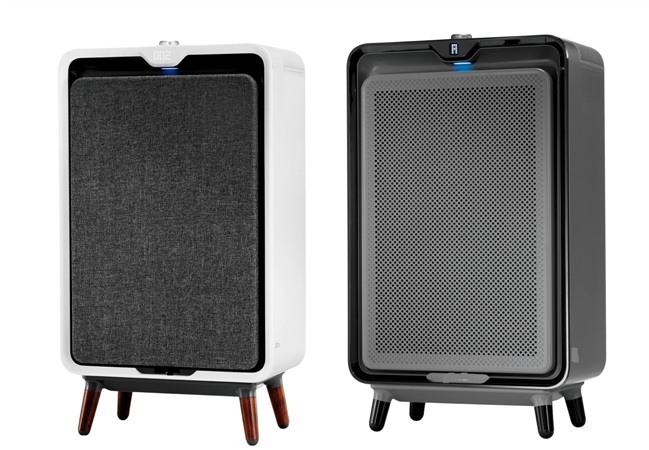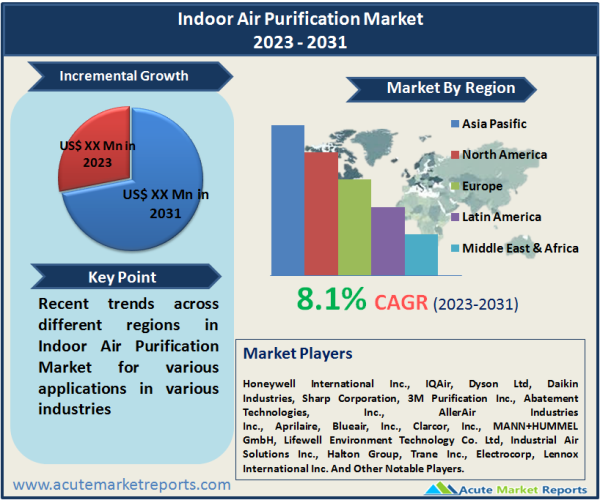
The indoor air purification market is expected to witness a CAGR of 8.1% during the forecast period of 2025 to 2033, driven by increasing awareness of the importance of clean and healthy indoor air. The indoor air purification market is driven by health awareness, pandemic concerns, and environmental consciousness, with the initial cost of quality systems as a restraint. Market segments are influenced by product demand and technology preferences. Geographic trends reveal regional disparities, and top companies are focused on innovation and strategic partnerships to cater to the growing market demand. The future of the indoor air purification market appears promising, with a growing emphasis on clean and healthy indoor environments.

Increasing Health Concerns
The foremost driver of the indoor air purification market is the growing concern for health and well-being. Poor indoor air quality can lead to a range of health issues, including allergies, respiratory diseases, and other ailments. In response to this, individuals, businesses, and institutions are investing in air purification systems to ensure that the air they breathe is free from pollutants and contaminants. In 2024, this trend led to a surge in the adoption of indoor air purifiers, especially in regions with high pollution levels. For example, in cities with poor outdoor air quality, such as New Delhi, Beijing, and Los Angeles, indoor air purification became a necessity. As we move into the forecast period from 2025 to 2033, the demand for air purification is expected to continue to rise, driven by the ongoing emphasis on health and well-being.
COVID-19 Pandemic Awareness
The COVID-19 pandemic had a profound impact on the indoor air purification market. The virus's mode of transmission through respiratory droplets and aerosols heightened awareness about the need for efficient air purification systems in various indoor environments. In 2024, the demand for air purifiers with HEPA filters and UV-C technology skyrocketed as people sought ways to minimize the risk of viral transmission indoors. The pandemic also prompted businesses, healthcare facilities, and educational institutions to invest in air purification solutions to create safer indoor environments. The lessons learned from the pandemic are expected to shape long-term behavior, making indoor air purification a vital component of indoor health and safety measures during the forecast period (2025-2033).
Environmental Concerns
Environmental consciousness is another key driver of the indoor air purification market. Many individuals and organizations are becoming more aware of the environmental impact of various indoor air pollutants, such as volatile organic compounds (VOCs), and are taking steps to reduce their carbon footprint. In 2024, there was a surge in demand for eco-friendly air purification systems that use sustainable materials and energy-efficient technologies. Consumers increasingly prefer products with lower energy consumption and those that produce fewer waste byproducts. This trend aligns with broader sustainability efforts and is likely to drive innovation in air purification technologies and materials, making them more environmentally friendly in the years to come.
Restraints
One of the main restraints for the indoor air purification market is the high initial cost of quality air purification systems. While the benefits of clean indoor air are undeniable, the upfront investment required for advanced air purifiers can be a deterrent for some consumers, especially in price-sensitive markets. In 2024, this cost factor limited the adoption of high-end air purification technologies. However, as the market matures and technologies become more accessible and affordable, this restraint is expected to ease during the forecast period (2025-2033).
Market Segmentation by Product: Dust Collectors and Vacuums Dominate the Market
The indoor air purification market can be segmented by product into Dust collectors & vacuums, Fume & smoke collectors, Mist eliminators, Fire & emergency exhaust, and Others. In 2024, the highest revenue was generated by Dust collectors & vacuums, reflecting the need for removing particulate matter from indoor environments, especially in industrial and healthcare settings. However, during the forecast period (2025-2033), Fume & smoke collectors are expected to exhibit the highest CAGR. This shift is driven by increasing concerns over the health hazards posed by airborne pollutants and stricter regulations in industries.
Market Segmentation by Technology: HEPA Technology Dominates the Market
The market can also be segmented by technology into Room temperature vulcanizing (RTV), High-Efficiency Particulate Arrestance (HEPA), Electrostatic precipitators, Activated carbon, Ionic filters, and Others. In 2024, HEPA technology generated the highest revenue, emphasizing the need for efficient removal of fine particles. However, during the forecast period (2025-2033), Activated carbon technology is expected to exhibit the highest CAGR due to its effectiveness in removing odors and gases, which is particularly appealing to consumers in residential settings.
APAC to Remain the Fastest Growing Market
Geographically, the indoor air purification market experiences regional variations. In 2024, North America and Europe accounted for the highest revenue percentage, driven by stringent indoor air quality regulations and a high level of consumer awareness. However, the Asia-Pacific region is expected to witness the highest CAGR during the forecast period. This is attributed to rising pollution levels, increasing urbanization, and a growing middle-class population with a greater ability to invest in air purification systems. The Middle East and Africa region is also expected to show significant growth as governments and businesses focus on improving indoor air quality.
Market Competition to Intensify during the Forecast Period
The indoor air purification market is highly competitive, with top players such as Honeywell International Inc., IQAir, Dyson Ltd, Daikin Industries, Sharp Corporation, 3M Purification Inc., Abatement Technologies, Inc., AllerAir Industries Inc., Aprilaire, Blueair, Inc., Clarcor, Inc., MANN+HUMMEL GmbH, Lifewell Environment Technology Co. Ltd, Industrial Air Solutions Inc., Halton Group, Trane Inc., Electrocorp and Lennox International Inc. dominating the industry. These companies have invested heavily in research and development to create innovative, efficient, and user-friendly air purification solutions. To maintain a competitive edge, companies are expected to continue innovating and diversifying their product portfolios during the forecast period (2025-2033). Additionally, partnerships with healthcare institutions and other industries, where air quality is critical, are expected to be key strategies to expand their market reach.
Historical & Forecast Period
This study report represents analysis of each segment from 2023 to 2033 considering 2024 as the base year. Compounded Annual Growth Rate (CAGR) for each of the respective segments estimated for the forecast period of 2025 to 2033.
The current report comprises of quantitative market estimations for each micro market for every geographical region and qualitative market analysis such as micro and macro environment analysis, market trends, competitive intelligence, segment analysis, porters five force model, top winning strategies, top investment markets, emerging trends and technological analysis, case studies, strategic conclusions and recommendations and other key market insights.
Research Methodology
The complete research study was conducted in three phases, namely: secondary research, primary research, and expert panel review. key data point that enables the estimation of Indoor Air Purification market are as follows:
Market forecast was performed through proprietary software that analyzes various qualitative and quantitative factors. Growth rate and CAGR were estimated through intensive secondary and primary research. Data triangulation across various data points provides accuracy across various analyzed market segments in the report. Application of both top down and bottom-up approach for validation of market estimation assures logical, methodical and mathematical consistency of the quantitative data.
| ATTRIBUTE | DETAILS |
|---|---|
| Research Period | 2023-2033 |
| Base Year | 2024 |
| Forecast Period | 2025-2033 |
| Historical Year | 2023 |
| Unit | USD Million |
| Segmentation | |
Product
| |
Technology
| |
Application
| |
|
Region Segment (2023-2033; US$ Million)
|
Key questions answered in this report